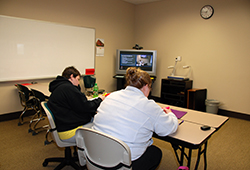NORFOLK, NE – Many college students are enrolled in courses that meet in classrooms with in-person instructors, but other learners are beginning to expand their class time opportunities by not even stepping foot on campus at all. Northeast Community College is among institutions that has embraced “eLearning,” defined as any mode of instruction in which there is a separation in the time or place between the students and instructors.
“When we think of a college classroom, we typically envision students sitting in front of an instructor and interacting face-to-face in real time. In eLearning, students are either removed from that location, are not with an instructor and are somewhere else or they are working at different times through some sort of online some platform,” said Faye Kilday, dean of humanities, arts and social sciences at Northeast.
eLearning has evolved over the past few years at Northeast. In the early days, there were “telecourses,” where students viewed lectures on VHS tape, worked on content and then deliver or mail in assignments. This form of learning at the College ended in 2013.
Kilday said the advancement in technology over the past five-years has changed things considerably in the realm of out-of-classroom learning experiences for students. The largest area Northeast has moved into is online.
She said, “Online is described as asynchronous learning, which means faculty have prepared the course content and students are able to access that course content at any time that works for them. There are course deadlines, but students can work at their convenience.”
One popular online class is world history. Instructors have developed a course that includes lectures, assignments and tests in the online environment and allows students to perform the work without having to come onto campus.
There are two other modes of eLearning.
Hybrid is a combination of synchronous and asynchronous, which means at least 50-percent of a course will be in a face-to-face setting between an instructor, a student and their classmates in a classroom. The other 50-percent of instruction is online, where students will do much of their course prep and homework.
“This is very popular in our courses that students find a little bit harder, such as English, math and science,” Kilday said.
“For some students, they still want some interaction with instructors so they can ask questions and work through difficult problems, however, they still want the flexibility of not having to come to class, so they can continue to work, if necessary.”
Distance education through interactive television (ITV) is a third mode. It is a synchronous form of learning that targets students at locations off campus. ITV features an instructor in one location with students in up to three other locations that allows everyone to interact with one another in real time. Kilday said this is a popular form of learning at Northeast’s extended campuses in O’Neill, South Sioux City and West Point, its regional offices in Ainsworth and Hartington, and at several area high schools.
In order to bring new tools in place to keep the technology to keep processes, including eLearning, up-to-date, Northeast has adopted a new learning management system (LMS) called Canvas. Canvas is a means where students are able to interact with instructors, classmates, and course information in order to be successful in class.
Kilday said Canvas is very user friendly for students and is intuitive for faculty. It features different platforms, which allows the use of multiple devices.
“Students no longer just have a desktop or a laptop computer ... they can now use their phones and/or tablets,” she said. “This is something that we have really worked on to make eLearning possible for our students as well as to make sure we have all the online resources available such as the data base system from the library, student services, advising, or to access financial aid. All of those tools are important for eLearning to be successful.”
While online may be convenient in some aspects, it still has its challenges, which Northeast is cognizant of and has addressed. eLearning represents a paradigm shift in higher education, according to Carla Streff, director of instructional technology and client services.
“eLearning is really more than just the tools that we offer to allow our students to take an online or ITV class. All of those tools and the way that we’re approaching eLearning is really transforming the classroom and higher education in general.”
Each eLearning course must go through Northeast’s quality standards; which students have come to appreciate.
One student said, “I like how Canvas is so easy to navigate. I also like the app feature that students can download onto their phone and then all of their grades and information come right to their phone with notifications.” Another said, “I like the simple functionality of the interface. It’s fairly easy to use and manipulate.”
Streff said they have also worked to ensure that faculty are properly trained and best practices are utilized when eLearning practices are applied.
“All faculty who teach through any of these modes need to go through a minimum of eight hours of training at Northeast. Most go through the minimum and then go through additional one-on-one training which is open to all faculty – full and part time and dual credit.”
To date, over 520 full and part-time Northeast faculty have been trained.
“Once they understand the tools, our student outcomes are much better,” Streff said.
eLearning at Northeast has seen success, which is evident by completion rates of students who take classes in this manner. Northeast’s completion rate of 79.5-percent far surpasses the national rate of 47-percent.
--###--

